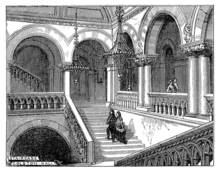Historic Colston Hall
The site has been occupied by four buildings named Colston Hall since the 1860s.[3] In the thirteenth century, the site was occupied by a Carmelite friary, known as Whitefriars. Subsequently, the location held a large Tudor-era mansion known as the Great House, used by Queen Elizabeth I in 1574 on a visit to the city. In 1707, Edward Colston established the Colston Boys' School in this building, which was acquired by the Colston Hall Company in 1861. Colston Hall opened as a concert venue on 20 September 1867.[3] The architects were the prolific Bristol firm of Foster & Wood, working in the Bristol Byzantine style.[4] It has been designated by English Heritage as a grade II listed building.[5]
Most of the building was damaged during a fire on 1 September 1898; the auditorium suffered immense structural damage, and the interior was more or less destroyed. The second hall opened in 1901,[6] and in 1919, the Corporation of Bristol purchased it from the Colston Hall Company. The City Council continues to manage the hall. The second hall was closed for remodelling in 1935.
In December 1936, the third hall was opened.[6] This survived the Luftwaffe air raids of the Second World War, but was burned down in 1945 after a discarded cigarette started a fire.[7] The hall was rebuilt once more, and the fourth reopened in 1951 to mark the Festival of Britain.[8] The first computerised booking system was installed in February 1983,[9] and a £500,000 modernisation programme was conducted at the start of the 1990s, which included extensive rewiring, and various backstage improvements.[10] The installation of removable seating in the front half of the stalls in 2005[10] improved the hall as a venue for pop concerts, providing space for fans to move around and dance in front of the stage; it also increased the overall capacity of the auditorium.
Campaigners, many from the city’s Afro-Caribbean community, have called for the hall’s name to be changed because of Edward Colston’s link to the slave trade, much of his wealth having come from that trade, and his investments in the Royal African Company.[11] The Bristol group Massive Attack vowed not to play at the venue while it retained its present name.[11] The proposal sparked a heated controversy in the pages of the local press, although the majority of letters printed favoured retaining the Colston name.[citation needed]
From 2007 to 2009, the Colston Hall underwent extensive refurbishment with the construction of a new foyer alongside the present building, topped by a wind turbine.[12][13]
The construction of the new foyer has allowed the old bar area, previously known as the "Little Theatre" or "Lesser Colston Hall"[14] to revert to being a performance space now known as "The Lantern" with a capacity of 350 standing,[15] plus new foyer performance spaces, education & meeting rooms, a restaurant, café and two bars in addition to the main hall that seats up to 2,075.

No comments:
Post a Comment